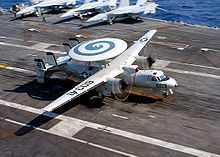VAW-123
| Carrier Airborne Early Warning Squadron One Two Three | |
|---|---|
|
VAW-123 Insignia | |
| Active | 1 April 1967 - present |
| Country |
|
| Branch |
|
| Type | Command and Control |
| Part of | Carrier Air Wing Three |
| Nickname | "Screwtops" |
| Aircraft | E-2C Hawkeye |
| Engagements |
Viet Nam, Operation Desert Shield Operation Desert Storm Operation Deny Flight Operation Deliberate Force Operation Southern Watch Global War on Terror |
| Decorations |
Battle Efficiency Award (13) Safety “S” Award (9) |
| Aircraft flown | |
| Electronic warfare | E-2 Hawkeye |

Carrier Airborne Early Warning Squadron 123 (VAW-123) also known as the World Famous "Screwtops" is a United States Navy Carrier Airborne Early Warning Squadron based at Naval Air Station Norfolk, Virginia. The "Screwtops" are an operational fleet squadron flying the E-2C Hawkeye. They were attached to Carrier Air Wing One (CVW-1) while deployed aboard the USS Enterprise (CVN-65).[1]
History
.jpg)
The history of VAW-123 begins in 1945 with the commissioning of VC-12, officially known as Composite Squadron Twelve. VC-12 was redesignated VAW-12, Carrier Airborne Early Warning Squadron Twelve, in 1956. During its history, the organization of VAW-123 changed internally many times. The last change resulted in the establishment of Carrier Airborne Early Warning Wing Twelve (CAEWW-12) and the commissioning of all E-2A detachments as independent squadrons. As a result of this reorganization, CAEWW-12, Detachment 59 was commissioned VAW-123 on April 1, 1967, at NAS Norfolk, Va. under the command of CDR Lucio W. Hill. The commissioning date of April 1, 1967 makes VAW-123 one of the oldest VAW Squadron in the United States Navy. In June 1967 VAW-123 set sail aboard USS Forrestal for Viet Nam, thus becoming the first East Coast VAW squadron to go to war. On July 29, 1967 while serving in the Gulf of Tonkin, Forrestal suffered a huge fire with the loss of 134 crew members, many crew members injured, many aircraft destroyed and millions of dollars in damage to the ship. Forrestal could not continue to serve in the condition the fire left her. She returned to Norfolk with VAW-123 and the rest of the ship's crew and Airwing. VAW-123 had no loss of any personnel or have any personnel injured in the fire aboard Forrestal. Some of the squadrons E-2A aircraft had very minor damage from the fire and explosions aboard the ship.[1]
Initially attached to CVW-17 aboard the USS Forrestal (CVA-59), the squadron became an integral part of CVW-3 aboard the USS Saratoga (CVA-60) and remained there throughout the 1970s. In 1972 VAW-123 again made an extended cruise to Vietnam waters in the Tonkin Gulf returning to Norfolk in 1973. In October 1980, the squadron transferred to CVW-11 aboard the USS America (CVA-66). Following a 1981 Indian Ocean deployment, VAW-123 transferred to CVW-1 on 12 November 1981. Since that time, the Screwtops have made several extended Indian Ocean, Mediterranean Sea, and North Atlantic deployments as an integral part of the CVW-1/CVA-66 team, until the decommissioning of the USS America in the Spring of 1997.[1]
Throughout the years, VAW-123 has consistently been at the forefront of the Airborne Early Warning community. In addition to being recipients of many awards, including eleven Battle "E's" and nine "Safety S's," the eleventh Battle "E" being awarded for 1999. Highlights of the command's history include the successful employment of the E-2C in 1973 and the first operational deployment of the E-2C ARPS (Advanced Radar Processing System) in 1978. In March 1996, the Screwtops became the first E-2 squadron on the East Coast to transition to the E-2C Group II aircraft, with its significantly upgraded avionics and engines. In November 1998, the Screwtops again led the way by becoming the first operational squadron on the East Coast to accept delivery of the Navigation Upgrade E-2C Group II's.[1]
The Screwtops have successfully met many challenging assignments and maintained a watchful eye on world events, ever ready to support national policy. The Screwtops were key participants in the 1986 Gulf of Sidra operations off the coast of Libya, and were directly involved in the first combat use of the HARM (High speed Anti-Radiation Missile) and Harpoon weapon systems. The Screwtops supported Operation Desert Shield/Desert Storm and were the only E-2 squadron to operate in both the Red Sea and Persian Gulf. The Screwtops have also flown in support of Operations Deny Flight and Deliberate Force over Bosnia-Herzegovina and Operation Southern Watch over Iraq.[1]
The Screwtops, along with the rest of Carrier Air Wing One (CVW-1), attached to the USS George Washington (CVN-73) for one deployment cycle, returning home on 2 April 1998.[1]
On 18 May 1998, Carrier Air Wing One transferred off the USS George Washington, bringing the Screwtops to their a home aboard the USS John F. Kennedy (CVA-67). During July and August 1998, VAW-123 detached to Roosevelt Roads, Puerto Rico, in support of the United States' ongoing efforts to stem the flow of narcotics through the Caribbean.[1]
In November and December 1998, the Screwtops detached to the newly commissioned USS Harry S Truman (CVN-75) in support of her shakedown cruise and Orange Air operations against the USS Theodore Roosevelt Battle Group.[1]
The Screwtops were deployed aboard the USS Enterprise (CVN-65) [1] prior to its inactivation in 2013. In July 2014, the Screwtops were transferred to Carrier Air Wing 3, attached to Carrier Strike Group 10.
See also
References
External links
| ||||||||||||||||||||||||||||||||||||||||||||||||||||||||||||||||||||||||||||||

